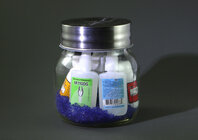Our woodworking club is investigating all hazardous substances and came across the ca glue accelerator as a potential fire hazard. Are there less hazardous accelerators available?
Thank you
Thank you
Given the chemistry involved, probably not.The issue at hand is how can the club reduce the health and flammability of the accelerator. Are there accelerators that are less of a hazard and flammability than others?

Dave,I found this video about CA glue fairly interesting
Thanks for the video! Love Veritasium, their videos are excellent.I found this video about CA glue fairly interesting
Once I (accidentally) glued my finger to something on the lathe and the debonder was just out of reach! Fortunately, a scalpel with a #11 blade was within reach.
John, that is a great idea. I'm borrowing it.I was told that it can cause a "chain reaction" and affect the entire bottle.
Also, apparently bottles of CA fail because the cheap, thin plastic used in most is permeable to water molecules in the air. Compare most bottles with those Mercury Adhesives use, much thicker and formulated, according to a spokesman, to exclude water molecules. Mercury also has, or had, an unconditional replacement warranty on any of their bottles that set up. I also bought some of their empty bottles for other glues.
But something I came up with years ago to extend the life of CA in small bottles: keep them in an air-tight container (preferably glass) with desiccant beads. This can remove any moisture that is in the air trapped inside. I thought of this decades ago and told a friend who started doing it. I then forgot about it until maybe 10 years later he told me how well it worked. So I started using it again. Another thing I started doing recently was displacing the air in CA bottles with Argon gas before screwing on the lid.
I use blue indicator desiccant beads which turn pink when they need to be recharged.
JKJ
LOL, thanks for the visual.
The desiccant? As mentioned, I thought of this many years ago and told my friend Joe, then forgot about it myself. I finally started doing it myself.John, that is a great idea. I'm borrowing it.
I bought a pack of scalpels a couple of months ago. I'll have to remember to keep one withing arm's reach.I find scalpels invaluable in the shop, use them a lot. My favorite are the straight edge #11 blades (buy them by the 100) but the curved #10 are useful too. Sometimes I get disposable scalpels with blade on plastic handles but the handles are NOT strong. Much better are the stainless steel handles the right size for the blades. Besides separating glued fingers they're useful anywhere you need an an small but extremely sharp knife. Good for impromptu surgeries on farm animals too.
Is it the accelerator which is flammable or the projection medium of the aerosol spray can?
I use accelerant in a pump spray bottle and never thought about whether flammable. Will check the bottle and maybe give a pump to a candle
Mr. Google says yes on pump because of solvents used.Is it the accelerator which is flammable or the projection medium of the aerosol spray can?
I use accelerant in a pump spray bottle and never thought about whether flammable. Will check the bottle and maybe give a pump to a candle
Is it the accelerator which is flammable or the projection medium of the aerosol spray can?
I use accelerant in a pump spray bottle and never thought about whether flammable. Will check the bottle and maybe give a pump to a candle
Our woodworking club is investigating all hazardous substances and came across the ca glue accelerator as a potential fire hazard. Are there less hazardous accelerators available?
I didn't read all of these replies but the accelerator I believe contains mainly acetone which is flammable. As for a pressure can, Starbond, which our club buys in bulk, is available in either aerosol can or pump spray bottle which.
